BAEKELAND, L.H. Leo Hendrik Baekeland (November 14, 1863 - February 23, 1944) was a Belgian-born American chemist who invented Velox photographic paper (1893) and Bakelite (1907), an inexpensive, nonflammable, versatile, and very popular plastic.BATTERYA battery is a device that converts chemical energy into electrical energy. Each battery has two electrodes, an anode (the positive end) and a cathode (the negative end). An electrical circuit runs between these two electrodes, going through a chemical called an electrolyte (which can be either liquid or solid). This unit consisting of two electrodes is called a cell (often called a voltaic cell or pile). Batteries are used to power many devices and make the spark that starts a gasoline engine.Alessandro Volta was an Italian physicist invented the first chemical battery in 1800.Storage batteries are lead-based batteries that can be recharged. In 1859, the French physicist Gaston Plante (1834-1889) invented a battery made from two lead plates joined by a wire and immersed in a sulfuric acid electrolyte; this was the first storage battery.The dry cell is a an improved voltaic cell with a cylindrical zinc shell (the zinc acts as both the cathode and the container) that is lined with an ammonium chloride (the electrolyte) saturated material (and not a liquid). The dry cell battery was developed in the 1870s-1870s by Georges Leclanche of France, who used an electrolyte in the form of a paste.Edison batteries (also called alkaline batteries) are an improved type of storage battery developed by Thomas Edison. These batteries have an alkaline electrolyte, and not an acid.
Leo Hendrik Baekeland (November 14, 1863 - February 23, 1944) was a Belgian-born American chemist who invented Velox photographic paper (1893) and Bakelite (1907), an inexpensive, nonflammable, versatile, and very popular plastic.BATTERYA battery is a device that converts chemical energy into electrical energy. Each battery has two electrodes, an anode (the positive end) and a cathode (the negative end). An electrical circuit runs between these two electrodes, going through a chemical called an electrolyte (which can be either liquid or solid). This unit consisting of two electrodes is called a cell (often called a voltaic cell or pile). Batteries are used to power many devices and make the spark that starts a gasoline engine.Alessandro Volta was an Italian physicist invented the first chemical battery in 1800.Storage batteries are lead-based batteries that can be recharged. In 1859, the French physicist Gaston Plante (1834-1889) invented a battery made from two lead plates joined by a wire and immersed in a sulfuric acid electrolyte; this was the first storage battery.The dry cell is a an improved voltaic cell with a cylindrical zinc shell (the zinc acts as both the cathode and the container) that is lined with an ammonium chloride (the electrolyte) saturated material (and not a liquid). The dry cell battery was developed in the 1870s-1870s by Georges Leclanche of France, who used an electrolyte in the form of a paste.Edison batteries (also called alkaline batteries) are an improved type of storage battery developed by Thomas Edison. These batteries have an alkaline electrolyte, and not an acid. BASKETBALL
 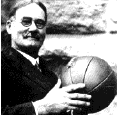 The game of basketball was invented by James Naismith (1861-1939). Naismith was a Canadian physical education instructor who invented the game in 1891 so that his students could participate in sports during the winter. In his original game, which he developed while at the Springfield, Massachusetts YMCA (Young Men's Christian Association), Naismith used a soccer ball which was thrown into peach baskets (with the basket bottoms intact). The first public basketball game was in Springfield, MA, USA, on March 11, 1892. Basketball was first played at the Olympics in Berlin Germany in 1936 (America won the gold medal, and Naismith was there). The game of basketball was invented by James Naismith (1861-1939). Naismith was a Canadian physical education instructor who invented the game in 1891 so that his students could participate in sports during the winter. In his original game, which he developed while at the Springfield, Massachusetts YMCA (Young Men's Christian Association), Naismith used a soccer ball which was thrown into peach baskets (with the basket bottoms intact). The first public basketball game was in Springfield, MA, USA, on March 11, 1892. Basketball was first played at the Olympics in Berlin Germany in 1936 (America won the gold medal, and Naismith was there). |
BELL, ALEXANDER GRAHAM
Alexander Graham Bell (March 3, 1847, Edinburgh, Scotland - August 2, 1922, Baddek, Nova Scotia) invented the telephone (with Thomas Watson) in 1876. Bell also improved Thomas Edison's phonograph. Bell invented the multiple telegraph (1875), the hydroairplane, the photo-sensitive selenium cell (the photophone, a wireless phone, developed with Sumner Tainter), and new techniques for teaching the deaf to speak. In 1882, Bell and his father-in-law, Gardiner Hubbard, bought and re-organized the journal "Science." Bell, Hubbard and others founded the National Geographic Society in 1888; Bell was the President of the National Geographic Society from 1898 to 1903.
BLUE JEANSLevi Strauss (1829-1902) was an entrepreneur who invented and marketed blue jeans. Trained as a tailor in Buttenheim, Bavaria, Germany, Strauss went to San Francisco, USA from New York in 1853. Strauss sold dry goods, including tents and linens to the 49ers (the people who came to the California gold rush, which began in 1849). In 1873, Strauss and Jacob Davis, a Nevada tailor, patented the idea (devised by Davis) of using copper rivets at the stress points of sturdy work pants. Early levis, called "waist overalls," came in a brown canvas duck fabric and a heavy blue denim fabric. The duck fabric pants were not very successful, so were dropped early on. His business became extremely successful (and still is), revolutionizing the apparel industry.BRAILLE TYPEWRITERThe Hall Braille typewriter (also called a Braillewriter or Brailler) was invented in 1892 by Frank Haven Hall. Hall was the Superintendent of the Illinois Institution for the Blind. The Hall Braille typewriter was manufactured by the Harrison & Seifried company in Chicago, Illinois, USA. Hall introduced his invention on May 27, 1892, at Jacksonville, Illinois. It types raised Braille dots onto paper.BUNSEN BURNER
 The laboratory Bunsen burner was invented by Robert Wilhelm Bunsen in 1855. Bunsen (1811-1899) was a German chemist and teacher. He invented the Bunsen burner for his research in isolating chemical substances - it has a high-intensity, non-luminous flame that does not interfere with the colored flame emitted by chemicals being tested.BURBANK, LUTHER
The laboratory Bunsen burner was invented by Robert Wilhelm Bunsen in 1855. Bunsen (1811-1899) was a German chemist and teacher. He invented the Bunsen burner for his research in isolating chemical substances - it has a high-intensity, non-luminous flame that does not interfere with the colored flame emitted by chemicals being tested.BURBANK, LUTHER
 Luther Burbank (1849-1926) was an American plant breeder who developed over 800 new strains of plants, including many popular varieties of potato, plums, prunes, berries, trees, and flowers. One of his greatest inventions was the Russet Burbank potato (also called the Idaho potato), which he developed in 1871. This blight-resistant potato helped Ireland recover from its devastating potato famine of 1840-60. Burbank also developed the Flaming Gold nectarine, the Santa Rosa plum, and the Shasta daisy. Burbank was raised on a farm and only went to elementary school; he was self-educated. Burbank applied the works of Charles Darwin to plants. Of Darwin's The Variation of Animals and Plants under Domestication, Burbank said, "It opened up a new world to me."CARVER, GEORGE WASHINGTON
Luther Burbank (1849-1926) was an American plant breeder who developed over 800 new strains of plants, including many popular varieties of potato, plums, prunes, berries, trees, and flowers. One of his greatest inventions was the Russet Burbank potato (also called the Idaho potato), which he developed in 1871. This blight-resistant potato helped Ireland recover from its devastating potato famine of 1840-60. Burbank also developed the Flaming Gold nectarine, the Santa Rosa plum, and the Shasta daisy. Burbank was raised on a farm and only went to elementary school; he was self-educated. Burbank applied the works of Charles Darwin to plants. Of Darwin's The Variation of Animals and Plants under Domestication, Burbank said, "It opened up a new world to me."CARVER, GEORGE WASHINGTON
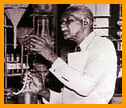 George Washington Carver (1865?-1943) was an American scientist, educator, humanitarian, and former slave. Carver developed hundreds of products from
George Washington Carver (1865?-1943) was an American scientist, educator, humanitarian, and former slave. Carver developed hundreds of products from ,
potatoes, pecans, and soybeans; his discoveries greatly improved the agricultural output and the health of Southern farmers. Before this, the only main crop in the South was cotton. The products that Carver invented included a rubber substitute, adhesives, foodstuffs, dyes, pigments, and many other products.CASH REGISTERThe mechanical cash register was invented (and patented) in 1879 by James Ritty (1836-1918). Ritty was an American tavern keeper in Dayton, Ohio. He nicknamed his cash register the "Incorruptible Cashier," and started the National Manufacturing Company to sell them. When a transaction was completed, a bell rang on the cash register and the amount was noted on a large dial on the front of the machine. During each sale, a paper tape was punched with holes so that the merchant could keep track of sales (at the end of the day, the merchant could add up the holes).John H. Patterson (1844-1922) bought Ritty's patent and his cash register company in 1884. Patterson renamed the Dayton, Ohio, company the National Cash Register Company. Patterson improved Ritty's cash register by adding a paper tape that kept a printed record of all transactions.
In 1906, Charles F. Kettering (and employee of NCR) developed an electric cash register (Kettering later worked for General Motors and invented the electric car ignition).
The National Cash Register Company was later called NCR, until the company was bought by ATT in 1991; it was given back the name NCR in 1996, when it was split off from ATT.
CELLULOID
Celluloid is a plastic made from cellulose (it is derived from plants). This very flammable material was invented in 1869 by the American inventor John Wesley Hyatt (it was invented to be a substitute for the elephant ivory used for billiard balls). Celluloid was one the first plastics invented; it can be damaged by moisture.
COCA-COLA
John Pemberton (1830-1888) invented Coca-Cola on May 8th, 1886 in Atlanta, Georgia, USA. He had invented many syrups, medicines, and elixirs before, including a very popular drink called French Wine of Coca, which contained French Bordeux wine, cocaine, and caffeine (from the kola nut). When Atlanta banned alcohol consumption in 1885, Pemberton had to change the formula of his French Wine of Coca, omitting the French wine. He added sugar, citric acid and essential oils of many fruits to the drink, and the original Coca-Cola was created (named for its main ingredients, cocaine and the kola nut). It quickly became a very popular soda fountain drink. Pemberton became partners with Frank Robinson and David Roe, but the partnership soon quarreled. Pemberton sold his interest in Coca-Cola. Cocaine is no longer an ingredient of Coca-Cola, but caffeine, sugar, citric acid, and fruit oils remain (although the formula is a closely-guarded secret).
COTTON CANDY
 Cotton candy is a soft confection made from sugar that is heated and spun into slim threads that look like a mass of cotton. It was invented in 1897 by William Morrison and John C. Wharton, candymakers from Nashville, Tennessee.
Cotton candy is a soft confection made from sugar that is heated and spun into slim threads that look like a mass of cotton. It was invented in 1897 by William Morrison and John C. Wharton, candymakers from Nashville, Tennessee.
DISHWASHER
The first dishwasher was patented in 1850 by Joel Houghton; his machine was a hand-turned wheel that splashed water on dishes - unfortunately, it wasn't very effective at washing dishes. The first working automatic dishwasher was invented by Mrs. Josephine Garis (W. A.) Cochran, of Shelbyville, Illinois, in 1889. Her dishwasher was a wooden tub with a wire basket in it - the dishes went in the basket, and rollers rotated the dishes. As a handle on the tub was turned, hot, soapy water was sprayed into the tub, cleaning the dishes. Cochran's machine was first shown at the 1893 World's Fair in Chicago, Illinois. At first, her machine was only bought by some restaurants and hotels. Cochran's small company was eventually associated with the KitchenAid company. The dishwasher didn't become widespread as a labor-saving machine until the 1960s. |
DORTICUS, CLATONIA JOAQUIN
Clatonia Joaquin Dorticus was an African-American inventor who received many patents. He invented an apparatus for applying dyes to the sides of the soles and heels of shoes (patent # 535,820, March 19, 1895), a machine for embossing (contouring the paper of) photographs (patent # 537,442, April 16, 1895), a device that helped develop photographs (patent # 537,968, April 23, 1895), and a leak stopper for hoses (patent # 629,315, July 18, 1899). |
EASTMAN, GEORGE
 George Eastman (1854-1932) was an American inventor who made many improvements in photography. Eastman invented the dry plate method in 1879; this was an improvement in the wet plate process photographic process). He founded the Eastman Dry Plate company in 1881, located in Rochester, New York. Eastman and William Walker invented flexible roll film in 1882, eliminating the necessity of using cumbersome glass plates for photography. Eastman produced the first simple, all-purpose, fixed-focus camera in 1888, which sold for $25.00; this was the first KODAK Camera . By 1900, Eastman Kodak was producing a camera that cost only one dollar. Early cameras took round pictures. To get the film developed, the photographer had to send the entire camera to the Rochester factory. The company name was changed to Eastman Kodak Company in 1892, and is still one of the largest photographic companies in the world. George Eastman (1854-1932) was an American inventor who made many improvements in photography. Eastman invented the dry plate method in 1879; this was an improvement in the wet plate process photographic process). He founded the Eastman Dry Plate company in 1881, located in Rochester, New York. Eastman and William Walker invented flexible roll film in 1882, eliminating the necessity of using cumbersome glass plates for photography. Eastman produced the first simple, all-purpose, fixed-focus camera in 1888, which sold for $25.00; this was the first KODAK Camera . By 1900, Eastman Kodak was producing a camera that cost only one dollar. Early cameras took round pictures. To get the film developed, the photographer had to send the entire camera to the Rochester factory. The company name was changed to Eastman Kodak Company in 1892, and is still one of the largest photographic companies in the world. |
EDISON, THOMAS ALVA
 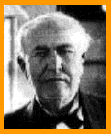 Thomas Alva Edison (1847-1931) was an American inventor (also known as the Wizard of Menlo Park) whose many inventions revolutionized the world. His work includes improving the incandescent electric light bulb and inventing the phonograph, the phonograph record, the carbon telephone transmitter, and the motion-picture projector. Thomas Alva Edison (1847-1931) was an American inventor (also known as the Wizard of Menlo Park) whose many inventions revolutionized the world. His work includes improving the incandescent electric light bulb and inventing the phonograph, the phonograph record, the carbon telephone transmitter, and the motion-picture projector.Edison's first job was as a telegraph operator, and in the course of his duties, he redesigned the stock-ticker machine. The Edison Universal Stock Printer gave him the capital ($40,000) to set up a laboratory in Menlo Park, New Jersey, to invent full-time (with many employees). Edison experimented with thousands of different light bulb filaments to find just the right materials to glow well, be long-lasting, and be inexpensive. In 1879, Edison discovered that a carbon filament in an oxygen-free bulb glowed but did not burn up for quite a while. This incandescent bulb revolutionized the world. |
ELEVATOR BRAKE
In 1854, at the Crystal Palace Exposition in New York, Otis demonstrated how safe his elevator was by cutting the elevator's cable with an ax, and the elevator car stayed where it was in the shaft. Otis' invention spurred the development of skyscrapers, changing the look of cities around the world forever. |
ESCALATOR
An escalator is a moving stairway that helps people move easily from floor to floor in building. The escalator was invented by the American inventor Jesse W. Reno in 1891. On his "inclined elevator," passengers rode on an wedge-shaped supports attached to a conveyor belt at an incline of about 25 degrees. The original elevator had a stationary handrail (which was soon replaced with a moving handrail).Horizontal steps were added to the escalator by Georg A. Wheeler and Charles D. Seeberger (who bought Wheeler's patent) in the late 1890's. The Otis company later bought the patents for the escalator and marketed it worldwide. The word escalator was first used at the Paris Exposition of 1900, when the Otis Company exhibited the moving stairway. |
FOUCAULT, JEAN
 Jean Bernard Léon Foucault (1819-1868) was a French physicist who invented the (1852) and the Foucault pendulum (1851). A gyroscope is essentially a spinning wheel set in a movable frame. When the wheel spins, it retains its spatial orientation, and it resists external forces applied to it. Gyroscopes are used in navigation instruments (for ships, planes, and rockets). Foucault was the first person to demonstrate how a pendulum could track the rotation of the Earth (the Foucault pendulum) in 1851. He also showed that light travels more slowly in water than in air (1850) and improved the mirrors of reflecting telescopes (1858). Jean Bernard Léon Foucault (1819-1868) was a French physicist who invented the (1852) and the Foucault pendulum (1851). A gyroscope is essentially a spinning wheel set in a movable frame. When the wheel spins, it retains its spatial orientation, and it resists external forces applied to it. Gyroscopes are used in navigation instruments (for ships, planes, and rockets). Foucault was the first person to demonstrate how a pendulum could track the rotation of the Earth (the Foucault pendulum) in 1851. He also showed that light travels more slowly in water than in air (1850) and improved the mirrors of reflecting telescopes (1858). |
FOX, SAMUEL
 Samuel Fox (1815 - 1887), an English inventor and manufacturer, invented the steel ribbed in 1852 (the ribs of the umbrella hold the fabric in place - wood or whale bone had been used as ribs before Fox's invention). Fox started the "English Steels Company," which manufactured his new umbrella. Samuel Fox (1815 - 1887), an English inventor and manufacturer, invented the steel ribbed in 1852 (the ribs of the umbrella hold the fabric in place - wood or whale bone had been used as ribs before Fox's invention). Fox started the "English Steels Company," which manufactured his new umbrella. |
FROEBEL, WILHELM A.
Friedrich Wilhelm August Froebel (also written Fröbel) (1782-1852) was a German educator and educational reformer who invented the kindergarten (which means "garden of children"). He opened the first kindergarten in Bad Blankenburg (near Keilhau) in 1837. Froebel founded a kindergarten training school at Liebenstein, Germany in 1849. After some conflicts and mistaken charges of treason, the German government banned the establishment of kindergartens in 1851. In 1860, the government repealed the ban, and kindergartens re-opened (unfortunately, this was after Froebel's death). Froebel's kindergartens included pleasant surroundings, self-motivated activity, play, music, and the physical training of the child. |
FOUNTAIN PEN
 Lewis E. Waterman was an American inventor and insurance salesman who developed a relatively leak-proof fountain pen; he patented his new invention in 1884 and revolutionized writing. Before his fountain pen, pen tips had to be tipped into ink after every few words. Waterman put an ink reservoir in the pen above the pen's metal nib (point). This reservoir would hold enough ink for a few pages of writing. There were many problems in developing the fountain pen, especially the difficulty of controlling the flow of the ink. Putting a sealed reservoir above the nib wouldn't let the ink flow, but if it wasn't sealed, all the ink would flow at once. Waterman used capillary action to replace the ink in the rubber sac with air so that the ink flowed smoothly but did not flow all at once. Also, the metals in the ink dissolved the steel pen nib, so Waterman used an iridium-plated gold nib. Waterman was also the first person to place a clip on the cap of the pen. Lewis E. Waterman was an American inventor and insurance salesman who developed a relatively leak-proof fountain pen; he patented his new invention in 1884 and revolutionized writing. Before his fountain pen, pen tips had to be tipped into ink after every few words. Waterman put an ink reservoir in the pen above the pen's metal nib (point). This reservoir would hold enough ink for a few pages of writing. There were many problems in developing the fountain pen, especially the difficulty of controlling the flow of the ink. Putting a sealed reservoir above the nib wouldn't let the ink flow, but if it wasn't sealed, all the ink would flow at once. Waterman used capillary action to replace the ink in the rubber sac with air so that the ink flowed smoothly but did not flow all at once. Also, the metals in the ink dissolved the steel pen nib, so Waterman used an iridium-plated gold nib. Waterman was also the first person to place a clip on the cap of the pen. |
GOODE, SARAH S.
Sarah E. Goode was a businesswoman and inventor. Goode invented the folding cabinet bed, a space-saver that folded up against the wall into a cabinet. When folded up, it could be used as a desk, complete with compartments for stationery and writing supplies. Goode owned a furniture store in Chicago, Illinois, and invented the bed for people living in small apartments. Goode's patent was the first one obtained by an African-American woman inventor (patent #322,177, approved on July 14, 1885). |
GYROSCOPE
 A gyroscope is essentially a spinning wheel set in a movable frame. When the wheel spins, it retains its spatial orientation, and it resists external forces applied to it. Gyroscopes are used in navigation instruments (for ships, planes, and rockets). (1819-1868), a French physicist, invented the gyroscope in 1852. A gyroscope is essentially a spinning wheel set in a movable frame. When the wheel spins, it retains its spatial orientation, and it resists external forces applied to it. Gyroscopes are used in navigation instruments (for ships, planes, and rockets). (1819-1868), a French physicist, invented the gyroscope in 1852. |
HOT DOGS
 Hot dogs began as sausages sold in buns. They were first sold from carts by German immigrants on the streets of New York City in the 1860s. The bun replaced a plate and made the hot dog easier to carry and eat. Sauerkraut was provided as a relish on the hot dog. Hot dogs began as sausages sold in buns. They were first sold from carts by German immigrants on the streets of New York City in the 1860s. The bun replaced a plate and made the hot dog easier to carry and eat. Sauerkraut was provided as a relish on the hot dog. |
HYATT, JOHN WESLEY
Celluloid is a plastic made from cellulose (it is derived from plants). This very flammable material was invented in 1869 by the American inventor John Wesley Hyatt (it was invented to be a substitute for the elephant ivory used for billiard balls). Celluloid was one the first plastics invented; it can be damaged by moisture. |
IRON, ELECTRIC
 The electric iron was invented in 1882 by Henry W. Seeley, a New York inventor Seeley patented his "electric flatiron" on June 6, 1882 (patent no. 259,054). His iron weighed almost 15 pounds and took a long time to warm up. The electric iron was invented in 1882 by Henry W. Seeley, a New York inventor Seeley patented his "electric flatiron" on June 6, 1882 (patent no. 259,054). His iron weighed almost 15 pounds and took a long time to warm up.Other electric irons had also been invented, including one from France (1882), but it used a carbon arc to heat the iron, a method which was dangerous. |
 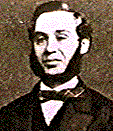 JEANS JEANS
Levi Strauss (1829-1902) was an entrepreneur who invented and marketed blue jeans. Trained as a tailor in Buttenheim, Bavaria, Germany, Strauss went to San Francisco, USA from New York in 1853. Strauss sold dry goods, including tents and linens to the 49ers (the people who came to the California gold rush, which began in 1849). In 1873, Strauss and Jacob Davis, a Nevada tailor, patented the idea (devised by Davis) of using copper rivets at the stress points of sturdy work pants. Early levis, called "waist overalls," came in a brown canvas duck fabric and a heavy blue denim fabric. The duck fabric pants were not very successful, so were dropped early on. His business became extremely successful (and still is), revolutionizing the apparel industry. |
JUDSON, WHITCOMB L.
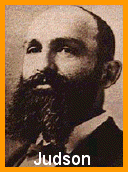  Whitcomb L. Judson was an American engineer from Chicago, Illinois, who invented a metal zipper device with locking teeth in 1890. Judson patented his "clasp-locker'' on Aug. 29, 1893; later in 1893, he exhibited this new invention at the Chicago World's Fair. He never succeeded in marketing his new device. The zipper was improved by the Swedish-American engineer, Gideon Sundbach, and was named by the B.F. Goodrich company in 1923. Judson died in 1909, before his device became commonly used and well-known Whitcomb L. Judson was an American engineer from Chicago, Illinois, who invented a metal zipper device with locking teeth in 1890. Judson patented his "clasp-locker'' on Aug. 29, 1893; later in 1893, he exhibited this new invention at the Chicago World's Fair. He never succeeded in marketing his new device. The zipper was improved by the Swedish-American engineer, Gideon Sundbach, and was named by the B.F. Goodrich company in 1923. Judson died in 1909, before his device became commonly used and well-known |
KINDERGARTEN
Kindergarten (which means "garden of children") was developed by Friedrich Wilhelm August Froebel (also written Fröbel) (1782-1852). Froebel was a German educator and educational reformer who opened the first kindergarten in Bad Blankenburg (near Keilhau) in 1837. Froebel founded a kindergarten training school at Liebenstein, Germany in 1849. After some conflicts and mistaken charges of treason, the German government banned the establishment of kindergartens in 1851. In 1860, the government repealed the ban, and kindergartens re-opened (unfortunately, this was after Froebel's death). Froebel's kindergartens included pleasant surroundings, self-motivated activity, play, music, and the physical training of the child. |
LATIMER, LEWIS H.
 Lewis Howard Latimer (1848-1928) was an African-American inventor who was a member of Edison'sresearch team, which was called "Edison's Pioneers." Latimer improved the newly-inventedincandescent light bulb by inventing a carbon filament (which he patented in 1881). Lewis Howard Latimer (1848-1928) was an African-American inventor who was a member of Edison'sresearch team, which was called "Edison's Pioneers." Latimer improved the newly-inventedincandescent light bulb by inventing a carbon filament (which he patented in 1881).
|
LECLANCHE, GEORGES
The dry cell is a an improved voltaic cell (battery) that has a cylindrical zinc shell (the zinc acts as both the cathode and the container) that is lined with an ammonium chloride (the electrolyte) saturated material (and not a liquid). Although called dry, dry cells are not entirely dry, but they are less bulky and more easily transported than earlier batteries. The dry cell battery was developed in the 1870s-1870s by Georges Leclanché (1839-1882), a French engineer, who used an electrolyte in the form of a paste in his new battery. |
  LIGHT BULB LIGHT BULB
The first electric light was made in 1800 by Humphry Davy, an English scientist. He experimented with electricity and invented an electric battery. When he connected wires to his battery and a piece of carbon, the carbon glowed, producing light. This is called an electric arc.Much later, in 1860, the English physicist Sir Joseph Wilson Swan (1828-1914) was determined to devise a practical, long-lasting electric light. He found that a carbon paper filament worked well, but burned up quickly. In 1878, he demonstrated his new electric lamps in Newcastle, England. In 1877, the American Charles Francis Brush manufactured some carbon arcs to light a public square in Cleveland, Ohio, USA. These arcs were used on a few streets, in a few large office buildings, and even some stores. Electric lights were only used by a few people. The inventor Thomas Alva Edison (in the USA) experimented with thousands of different filaments to find just the right materials to glow well and be long-lasting. In 1879, Edison discovered that a carbon filament in an oxygen-free bulb glowed but did not burn up for 40 hours. Edison eventually produced a bulb that could glow for over 1500 hours. In 1903, Willis R. Whitney invented a treatment for the filament so that it wouldn't darken the inside of the bulb as it glowed. In 1910, William David Coolidge (1873-1975) invented a tungsten filament which lasted even longer than the older filaments. The incandescent bulb revolutionized the world. |
LUNDSTROM, J.E.
Safety matches were invented by Johan Edvard Lundstrom of Sweden in 1855. Lundstrom's new match was the first simple and safe way to make a fire. His new safety match could only be lit by striking the match against the specially-prepared surface that came attached to the box. Lundstrom put red phosphorus on the rough striking paper (on the outside the match box); the other fire-starting chemicals were on the match's head. Previous matches gave long-time users an ailment called "phossy jaw;" this was a painful and deadly disease caused by the older matchs' yellow phosphorus that ate into the users' jaws. |
 MARCONI, GUGLIELMO MARCONI, GUGLIELMO
Guglielmo Marconi (1874-1937) was an Italian inventor and physicist. In 1895, Marconi invented the (wireless telegraphy), building machinery to transmit and receive radio waves. His first transmission across an ocean (the Atlantic Ocean) was on December 12, 1901. Marconi won the for Physics in 1909. |
McCOY, ELIJAH
 Elijah McCoy (1843 or 1844-1929) was a mechanical engineer and inventor. McCoy's high-quality industrial inventions (especially his steam engine lubricator) were the basis for the expression "the real McCoy," meaning the real, authentic, or high-quality thing. Elijah McCoy (1843 or 1844-1929) was a mechanical engineer and inventor. McCoy's high-quality industrial inventions (especially his steam engine lubricator) were the basis for the expression "the real McCoy," meaning the real, authentic, or high-quality thing. |
McCOY, ELIJAH
 Elijah McCoy (1843 or 1844-1929) was a mechanical engineer and inventor. McCoy's high-quality industrial inventions (especially his steam engine lubricator) were the basis for the expression "the real McCoy," meaning the real, authentic, or high-quality thing. Elijah McCoy (1843 or 1844-1929) was a mechanical engineer and inventor. McCoy's high-quality industrial inventions (especially his steam engine lubricator) were the basis for the expression "the real McCoy," meaning the real, authentic, or high-quality thing.
|
 MOTORCYCLE MOTORCYCLE
The earliest motorcycle was a coal-powered, two-cylinder, steam-driven motorcycle that was developed in 1867 by the American inventor . A gas-powered motorcycle was invented by the German inventor Gottlieb Daimler in 1885. His mostly wooden motorcycle had iron-banded wheels with wooden spokes. This bone-crunching vehicle was powered by a single-cylinder engine. |
  NAISMITH, JAMES NAISMITH, JAMES
James Naismith (1861-1939) was a Canadian physical education instructor who invented the game of basketballin 1891. He developed this indoor game so that his students could participate in sports during the winter. In his original game, which he invented while at the Springfield, Massachusetts YMCA (Young Men's Christian Association), Naismith used a soccer ball which were thrown into peach baskets (with their bottoms intact). The first public basketball game was in Springfield, MA, USA, on March 11, 1892. Basketball was first played at the Olympics in Berlin Germany in 1936 (America won the gold medal, and Naismith was there). Naismith was inducted into the Basketball Hall of Fame in 1978. |
 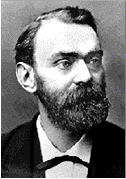 NOBEL, ALFRED NOBEL, ALFRED
Alfred Bernhard Nobel (1833-1896) was a Swedish inventor and industrialist. Nobel invented many powerful and relatively safe explosives and explosive devices, including the "Nobel patent detonator" (it detonated nitroglycerin using a strong electrical shock instead of heat, 1863), dynamite (1867), blasting gelatin (guncotton plus nitroglycerin, 1875), and almost smokeless blasting powder (1887). Nobel also made inventions in the fields of electrochemistry, optics, biology, and physiology. Nobel left much of his fortune to award prizes (the Nobel prizes) each year to people who made advancements in Physics, Chemistry, Physiology/Medicine, Literature, and Peace. |
OTIS, ELISHA GRAVES
Elisha Graves Otis (1811-1861) was an American mechanic and inventor. Otis invented the elevator brake, which greatly improved the safety of elevators. He used a ratchet on a spring to catch the elevator in the event of an accident (like a broken cable). In 1854, at the Crystal Palace Exposition in New York, Otis demonstrated how safe his elevator was by cutting the elevator's cable with an ax, and the elevator car stayed where it was in the shaft. Otis' invention spurred the development of skyscrapers, changing the look of cities around the world forever. Otis also invented a railway safety brake and improvements to turbine engines and brass bed frames. |
PAPER CLIP
 The paper clip was invented in 1899 or 1890 by a Norwegian patent clerk called Johann Vaaler. His original paper clip was a thin spring-steel wire with triangular or square ends and two "tongues." Vaaler patented his invention in Germany and later in the USA (1901). The paper clip was invented in 1899 or 1890 by a Norwegian patent clerk called Johann Vaaler. His original paper clip was a thin spring-steel wire with triangular or square ends and two "tongues." Vaaler patented his invention in Germany and later in the USA (1901).The modern-shaped paper clip was patented in April 27, 1899 by William Middlebrook of Waterbury, Connecticut, USA. |
PASTEUR, LOUIS
Louis Pasteur (1822-1895) was a French chemist and inventor. Pasteur studied the process of fermentation, and postulated that fermentation was produced by microscopic organisms (other than yeast), which Pasteur called germs. He hypothesized that these germs might be responsible for some diseases. Pasteur disproved the notion of "spontaneous generation " which stated that organisms could spring from nothing; Pasteur showed that organisms came form other, pre-existing organisms. Applying his theories to foods and drinks, Pasteur invented a heating process (now called pasteurization) which sterilizes food, killing micro-organisms that contaminate it. |
PLANTE, GASTON
In 1859, the French physicist Raymond Gaston Planté (April 22, 1834-1889) invented a battery made from two lead plates joined by a wire and immersed in a sulfuric acid electrolyte; this was the first storage battery. Storage batteries are batteries that can be recharged. |
POTATO CHIPS
The potato chip was invented in 1853 by George Crum. Crum was a Native American/African American chef at the Moon Lake Lodge resort in Saratoga Springs, New York, USA. French fries were popular at the restaurant and one day a diner complained that the fries were too thick. Although Crum made a thinner batch, the customer was still unsatisfied. Crum finally made fries that were too thin to eat with a fork, hoping to annoy the extremely fussy customer. The customer, surprisingly enough, was happy - and potato chips were invented!
|
PUSHPIN
The push pin("a thumbtack with an elongated handle that makes it easier to put in and remove") was invented by the Pennsylvanian inventor Edwin Moore in 1900. Moore started a company producing these useful pins in 1900. After years of growing, his company incorporated on July 19, 1904, and was called the "Moore Push-Pin Company." The company 1912 through 1977, the Company was located in Germantown, Pennsylvania. |
 RADIO RADIO
The radio was invented by Nikola Tesla. The radio was promoted and popularized by in 1895. The first radio transmission across an ocean (the Atlantic Ocean) occurred on December 12, 1901. |
RAYON
Rayon is a cellulose-based fiber that is made from wood pulp or cotton waste. Rayon is used as a substitute for silk. It was invented around 1855 by the Swiss chemist Georges Audemars; the process was refined in 1864 by the French chemist and industrialist Comte (Count) Hilaire Bernigaud de Chardonnet (1839-1924). Rayon was first commercially produced in 1910 by Avtex Fibers Inc. in the United States - it was called "artificial silk" at first, but the name was changed to rayon in 1924. |
RECORD
 Records, used to record sound, were invented in 1877 by , who invented the first machine to record and play back sounds (the phonograph or record player). Early records were cylindrical, but flat disks soon replaced them. Records, used to record sound, were invented in 1877 by , who invented the first machine to record and play back sounds (the phonograph or record player). Early records were cylindrical, but flat disks soon replaced them.
|
RENO, JESSE W.
Jesse W. Reno was an American inventor who developed the first escalator in 1891. An escalator is a moving stairway that helps people move easily from floor to floor in building. On his "inclined elevator," passengers rode on an wedge-shaped supports attached to a conveyor belt at an incline of about 25 degrees. The original elevator had a stationary handrail (which was soon replaced with a moving handrail). |
REVOLVING DOOR
The revolving door was invented in 1888 by Theophilus Van Kannel of Philadelphia, Pennsylvania. in high-rise buildings, regular doors are hard to open because there is a slight vacuum caused by air flowing upwards through stairwells, elevator shafts, and chimneys. Van Kannel's new type of door was easy to open in tall building (and also saved heat in the winter). Van Kannel patented the revolving door on August 7, 1888. |
RILLIEUX, NORBERT
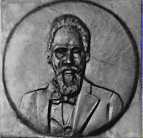 Norbert Rillieux (March 17, 1806-October 8, 1894) was an African-American inventor and engineer who invented a device that revolutionized sugar processing. Rillieux's multiple effect vacuum sugar evaporator (patented in 1864) made the processing of sugar more efficient, faster, and much safer. The resulting sugar was also superior. His apparatus was eventually adopted by sugar processing plants all around the world. Norbert Rillieux (March 17, 1806-October 8, 1894) was an African-American inventor and engineer who invented a device that revolutionized sugar processing. Rillieux's multiple effect vacuum sugar evaporator (patented in 1864) made the processing of sugar more efficient, faster, and much safer. The resulting sugar was also superior. His apparatus was eventually adopted by sugar processing plants all around the world.
|
 ROENTGEN, WILHELM VON ROENTGEN, WILHELM VON
X-rays were discovered in 1895 by Wilhelm Konrad von Roentgen (1845-1923). Roentgen was a German physicist who described this new form of radiation that allowed him to photograph objects that were hidden behind opaque shields. He even photographed part of his own skeleton. X-rays were soon used as an important diagnostic tool in medicine. Roentgen called these waves "X-radiation" because so little was known about them. |
 ROPER, SYLVESTER HOWARD ROPER, SYLVESTER HOWARD
Sylvester Howard Roper (1823-1896) was an American inventor from New Hampshire and Massachusetts. Roper developed a coal-powered, two-cylinder, steam-driven wooden motorcycle in 1867. Roper also developed a steam-driven car. Roper died at the age of 73 while testing a new motorcycle. |
SAFETY MATCHES
Safety matches were invented by Johan Edvard Lundstrom of Sweden in 1855. Lundstrom's new match was the first simple and safe way to make a fire. His new safety match could only be lit by striking the match against the specially-prepared surface that came attached to the box. Lundstrom put red phosphorus on the rough striking paper (on the outside the match box); the other fire-starting chemicals were on the match's head. Previous matches gave long-time users an ailment called "phossy jaw;" this was a painful and deadly disease caused by the older matchs' yellow phosphorus that ate into the users' jaws. |
  STRAUSS, LEVI STRAUSS, LEVI
Levi Strauss (1829-1902) was an entrepreneur who invented and marketed blue jeans. Trained as a tailor in Buttenheim, Bavaria, Germany, Strauss went to San Francisco, USA from New York in 1853. Strauss sold dry goods, including tents and linens to the 49ers (the people who came to the California gold rush, which began in 1849). In 1873, Strauss and Jacob Davis, a Nevada tailor, patented the idea (devised by Davis) of using copper rivets at the stress points of sturdy work pants. Early levis, called "waist overalls," came in a brown canvas duck fabric and a heavy blue denim fabric. The duck fabric pants were not very successful, so were dropped early on. His business became extremely successful (and still is), revolutionizing the apparel industry. |
  SWAN, JOSEPH WILSON SWAN, JOSEPH WILSON
The first practical electric light bulb was made in 1878 simultaneously (and independently) by Joseph Wilson Swan and Thomas Alva Edison .Sir Joseph Wilson Swan (1828-1914) was an English physicist who was determined to devise a practical, long-lasting electric light. After many years of experimentation, he found that a carbon paper filament worked well, but burned up quickly. In 1878, he demonstrated his new electric lamps in Newcastle, England. |
TELEPHONE
The telephone (meaning "far sound") is the most widely used telecommunications device. It was invented in 1876 by Alexander Graham Bell (with Thomas Watson). Bell patented his invention on March 1876 (patent No. 174,465). His device transmitted speech sounds over electric wires, and his idea has remained one of the most useful inventions ever made. |
TESLA, NIKOLA
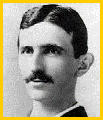 Nikola Tesla (1856-1943) was a Serbian-American inventor who developed the radio, fluorescent lights, the Tesla coil (an air-core transformer that generates a huge voltage from high-frequency alternating current), remote-control devices, and many other inventions; Tesla held 111 patents. Tesla developed and promoted the uses of alternating current (as opposed to direct current, which was promoted fiercely by Thomas Edison and General Electric). Tesla briefly worked with Thomas Edison . The unit of magnetic induction is named for Tesla; a tesla (abbreviated T) is equal to one weber per square meter. Nikola Tesla (1856-1943) was a Serbian-American inventor who developed the radio, fluorescent lights, the Tesla coil (an air-core transformer that generates a huge voltage from high-frequency alternating current), remote-control devices, and many other inventions; Tesla held 111 patents. Tesla developed and promoted the uses of alternating current (as opposed to direct current, which was promoted fiercely by Thomas Edison and General Electric). Tesla briefly worked with Thomas Edison . The unit of magnetic induction is named for Tesla; a tesla (abbreviated T) is equal to one weber per square meter.
|
TOILET PAPER
 Joseph Gayetty invented toilet paper in 1857. His new toilet paper was composed of flat sheets. Before Gayetty's invention, people tore pages out of mail order catalogs - before catalogs were common, leaves were used. Unfortunately, Gayetty's invention failed. Walter Alcock (of Great Britain) later developed toilet paper on a roll ( instead of in flat sheets). Again, the invention failed. Joseph Gayetty invented toilet paper in 1857. His new toilet paper was composed of flat sheets. Before Gayetty's invention, people tore pages out of mail order catalogs - before catalogs were common, leaves were used. Unfortunately, Gayetty's invention failed. Walter Alcock (of Great Britain) later developed toilet paper on a roll ( instead of in flat sheets). Again, the invention failed.In 1867, Thomas, Edward and Clarence Scott (brothers from Philadelphia, Pennsylvania, USA) were successful at marketing toilet paper that consisted of a small roll of perforated paper . They sold their new toilet paper from a push cart - this was the beginning of the Scott Paper Company. |
TRACTOR
 The tractor is a high power but low-speed vehicle that is used in farming, construction, road building, and other work projects. Some tractors move on wheels, others move on a continuous track. The first gasoline-powered tractor was made in 1892 by John Froehlich, a blacksmith from Iowa. The first mass-produced tractors were sold by C.W. Hart and C.H. Parr of Charles City, Iowa. The tractor is a high power but low-speed vehicle that is used in farming, construction, road building, and other work projects. Some tractors move on wheels, others move on a continuous track. The first gasoline-powered tractor was made in 1892 by John Froehlich, a blacksmith from Iowa. The first mass-produced tractors were sold by C.W. Hart and C.H. Parr of Charles City, Iowa. |
TYPEWRITER
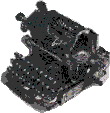 The first typewriter was invented in 1867 by the American printer and editor Christopher Latham Sholes (Feb. 14, 1819 - Feb. 17, 1890). Sholes' prototype had the user hit a key (for each letter and number), which struck upward onto a flat plate, producing a carbon impression of the letter or number on the paper. He made the prototype using the key of an old telegraph transmitter. There was no way of spacing the letters, no carriage return, and no shift keys; these features would be added to later models. The first typewriter was invented in 1867 by the American printer and editor Christopher Latham Sholes (Feb. 14, 1819 - Feb. 17, 1890). Sholes' prototype had the user hit a key (for each letter and number), which struck upward onto a flat plate, producing a carbon impression of the letter or number on the paper. He made the prototype using the key of an old telegraph transmitter. There was no way of spacing the letters, no carriage return, and no shift keys; these features would be added to later models.Carlos Glidden and Samuel W. Soulé also worked in the Kleinstuber Machine Shop with Sholes, and they helped with his inventions. Their first patent was obtained on June 23, 1868. Sholes and Glidden sold the rights to their invention to the investor James Densmore, who eventually had the machine commercially manufactured. Their first commercial model was called the "Sholes & Glidden Type Writer," and was later called the Remington typewriter. It was produced by the gunmakers E. Remington & Sons in Ilion, NY, from 1874-1878. The first author to submit a typed book manuscript was Mark Twain. Sholes' typewriter was the beginning of a revolution in communication. |
VAALER, JOHANN
 The paper clip was invented in 1899 or 1890 by a Norwegian patent clerk called Johann Vaaler. His original paper clip was a thin spring-steel wire with triangular or square ends and two "tongues." Vaaler patented his invention in Germany and later in the USA (1901). The paper clip was invented in 1899 or 1890 by a Norwegian patent clerk called Johann Vaaler. His original paper clip was a thin spring-steel wire with triangular or square ends and two "tongues." Vaaler patented his invention in Germany and later in the USA (1901).The modern-shaped paper clip was patented in April 27, 1899 by William Middlebrook of Waterbury, Connecticut, USA. |
VACUUM CLEANER
John S. Thurman invented the gasoline powered vacuum cleaner (which he called the "pneumatic carpet renovator") in 1899. His vacuum was patented on Oct. 3, 1899 (patent #634,042). It may have been the first motorized vacuum cleaner. Thurman had a run a horse drawn, door-to-door carpet vacuuming service in St. Louis, Missouri, USA, charging $4 per visit (which was a large amount of money at the time). |
 VON ROENTGEN, WILHELM VON ROENTGEN, WILHELM
X-rays were discovered in 1895 by Wilhelm Konrad von Roentgen (1845-1923). Roentgen was a German physicist who described this new form of radiation that allowed him to photograph objects that were hidden behind opaque shields. He even photographed part of his own skeleton. X-rays were soon used as an important diagnostic tool in medicine. Roentgen called these waves "X-radiation" because so little was known about them. |
WATERMAN, LEWIS E.
 Lewis E. Waterman was an American inventor and insurance salesman who developed a relatively leak-proof fountain pen; he patented his new invention in 1884 and revolutionized writing. Before his fountain pen, pen tips had to be tipped into ink after every few words. Waterman put an ink reservoir in the pen above the pen's metal nib (point). This reservoir would hold enough ink for a few pages of writing. There were many problems in developing the fountain pen, especially the difficulty of controlling the flow of the ink. Putting a sealed reservoir above the nib wouldn't let the ink flow, but if it wasn't sealed, all the ink would flow at once. Waterman used capillary action to replace the ink in the rubber sac with air so that the ink flowed smoothly but did not flow all at once. Also, the metals in the ink dissolved the steel pen nib, so Waterman used an iridium-plated gold nib. Waterman was also the first person to place a clip on the cap of the pen. Lewis E. Waterman was an American inventor and insurance salesman who developed a relatively leak-proof fountain pen; he patented his new invention in 1884 and revolutionized writing. Before his fountain pen, pen tips had to be tipped into ink after every few words. Waterman put an ink reservoir in the pen above the pen's metal nib (point). This reservoir would hold enough ink for a few pages of writing. There were many problems in developing the fountain pen, especially the difficulty of controlling the flow of the ink. Putting a sealed reservoir above the nib wouldn't let the ink flow, but if it wasn't sealed, all the ink would flow at once. Waterman used capillary action to replace the ink in the rubber sac with air so that the ink flowed smoothly but did not flow all at once. Also, the metals in the ink dissolved the steel pen nib, so Waterman used an iridium-plated gold nib. Waterman was also the first person to place a clip on the cap of the pen. |
 X-RAY X-RAY
X-rays were discovered in 1895 by Wilhelm Konrad von Roentgen (1845-1923). Roentgen was a German physicist who described this new form of radiation that allowed him to photograph objects that were hidden behind opaque shields. He even photographed part of his own skeleton. X-rays were soon used as an important diagnostic tool in medicine. Roentgen called these waves "X-radiation" because so little was known about them. |
  ZIPPER ZIPPER
Whitcomb L. Judson was an American engineer from Chicago, Illinois, who invented the zipper. Judson patented his "clasp-locker'' on Aug. 29, 1893; later in 1893, he exhibited this new invention at the Chicago World's Fair. He and Lewis Walker founded the Universal Fastener Company to manufacture these fasteners. They never succeeded in selling Judson's new device. Judson died in 1909, before his device became commonly used and well known.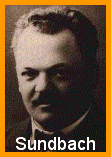 The zipper was improved in 1913 by the Swedish-American engineer, Gideon Sundbach (a former employee of Judson). Sundbach was successful at selling his invention, which he called the "Hookless 2." He sold these fasteners to the US Army, who put zippers on soldiers' clothing and gear during World War I. The zipper was improved in 1913 by the Swedish-American engineer, Gideon Sundbach (a former employee of Judson). Sundbach was successful at selling his invention, which he called the "Hookless 2." He sold these fasteners to the US Army, who put zippers on soldiers' clothing and gear during World War I.
The word zipper was coined by B.F. Goodrich in 1923, whose company sold rubber galoshes equipped with zippers. Goodrich is said to have named them zippers because he liked the zipping sound they made when opened and closed. |
 Leo Hendrik Baekeland (November 14, 1863 - February 23, 1944) was a Belgian-born American chemist who invented Velox photographic paper (1893) and Bakelite (1907), an inexpensive, nonflammable, versatile, and very popular plastic.
Leo Hendrik Baekeland (November 14, 1863 - February 23, 1944) was a Belgian-born American chemist who invented Velox photographic paper (1893) and Bakelite (1907), an inexpensive, nonflammable, versatile, and very popular plastic. The laboratory Bunsen burner was invented by Robert Wilhelm Bunsen in 1855. Bunsen (1811-1899) was a German chemist and teacher. He invented the Bunsen burner for his research in isolating chemical substances - it has a high-intensity, non-luminous flame that does not interfere with the colored flame emitted by chemicals being tested.
The laboratory Bunsen burner was invented by Robert Wilhelm Bunsen in 1855. Bunsen (1811-1899) was a German chemist and teacher. He invented the Bunsen burner for his research in isolating chemical substances - it has a high-intensity, non-luminous flame that does not interfere with the colored flame emitted by chemicals being tested. George Washington Carver (1865?-1943) was an American scientist, educator, humanitarian, and former slave. Carver developed hundreds of products from , potatoes, pecans, and soybeans; his discoveries greatly improved the agricultural output and the health of Southern farmers. Before this, the only main crop in the South was cotton. The products that Carver invented included a rubber substitute, adhesives, foodstuffs, dyes, pigments, and many other products.
George Washington Carver (1865?-1943) was an American scientist, educator, humanitarian, and former slave. Carver developed hundreds of products from , potatoes, pecans, and soybeans; his discoveries greatly improved the agricultural output and the health of Southern farmers. Before this, the only main crop in the South was cotton. The products that Carver invented included a rubber substitute, adhesives, foodstuffs, dyes, pigments, and many other products.Cotton candy is a soft confection made from sugar that is heated and spun into slim threads that look like a mass of cotton. It was invented in 1897 by William Morrison and John C. Wharton, candymakers from Nashville, Tennessee.
 Norbert Rillieux (March 17, 1806-October 8, 1894) was an African-American inventor and engineer who invented a device that revolutionized sugar processing. Rillieux's multiple effect vacuum sugar evaporator (patented in 1864) made the processing of sugar more efficient, faster, and much safer. The resulting sugar was also superior. His apparatus was eventually adopted by sugar processing plants all around the world.
Norbert Rillieux (March 17, 1806-October 8, 1894) was an African-American inventor and engineer who invented a device that revolutionized sugar processing. Rillieux's multiple effect vacuum sugar evaporator (patented in 1864) made the processing of sugar more efficient, faster, and much safer. The resulting sugar was also superior. His apparatus was eventually adopted by sugar processing plants all around the world.
There is SHOCKING news in the sports betting industry.
ReplyDeleteIt's been said that any bettor must watch this,
Watch this or quit betting on sports...
Sports Cash System - SPORTS CASINO ROBOT